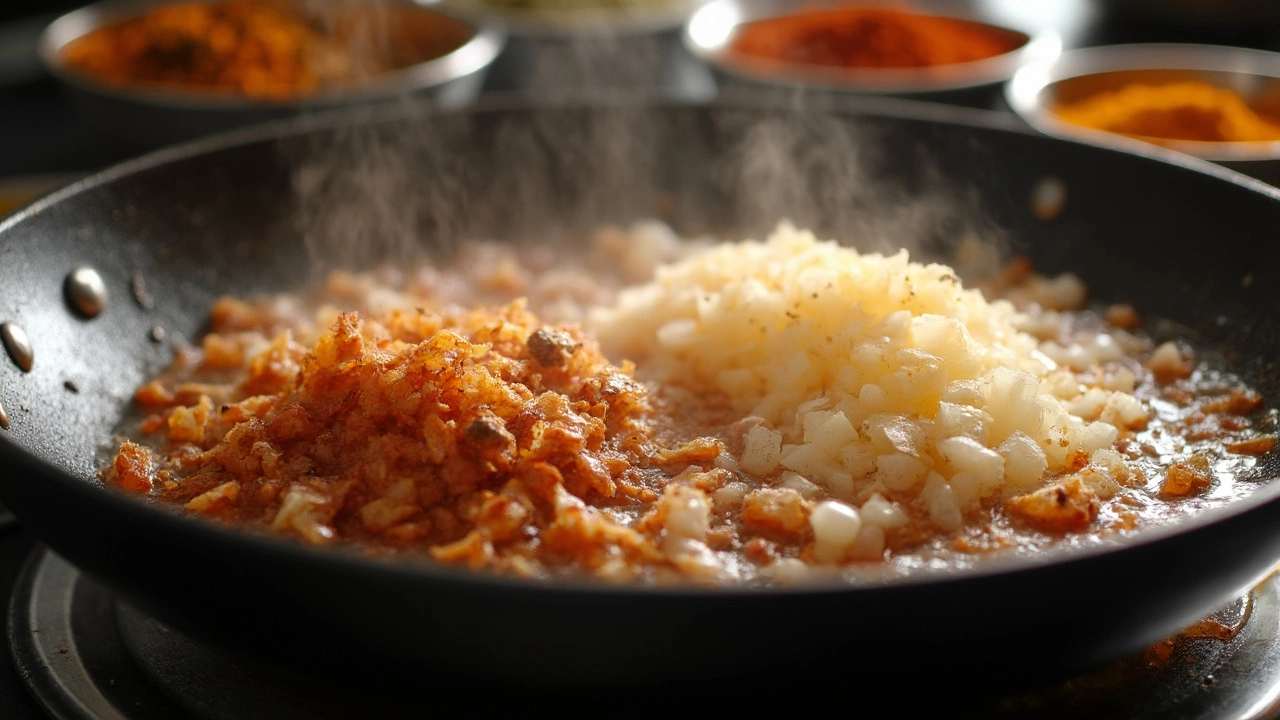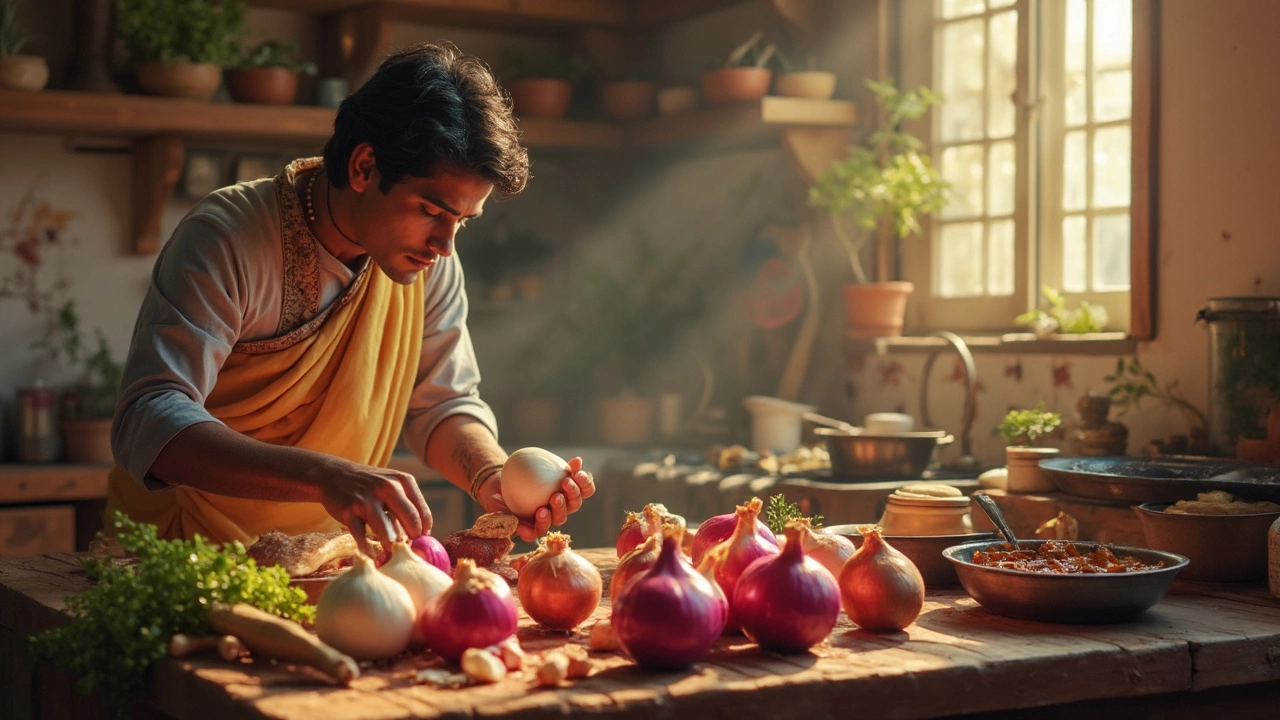Pop into any Indian kitchen when curry is bubbling, and you’ll see onions doing the heavy lifting. They’re not just tossed in for color. The choice between red and white onions totally shapes your chicken curry—from sweetness to that mouth-watering brown gravy.
Most of us grab whatever onions are at hand, but swapping red for white (or vice versa) isn’t just about color. Indian cooks get surprisingly picky about this. The right onion makes chicken curry sing; the wrong one leaves it tasting flat or weirdly sweet.
If you’re torn when picking up onions for tonight’s curry, you’re miles ahead of most people. Here’s what you really need to know before you chop, fry, and sizzle.
- The Role of Onions in Curry
- Red vs. White: Taste, Texture, and Color
- What Home Cooks and Street Vendors Use
- Tips for Perfect Curry Onions
The Role of Onions in Curry
If you’ve ever wondered why nearly every chicken curry recipe starts with onions sizzling in hot oil, you’re not alone. Onions are way more than just filler: they’re the base that gives curries their signature thickness, sweetness, and that rich, almost caramel-like taste you remember from mom’s kitchen.
When onions break down during slow cooking, their natural sugars release and lend a slight sweetness that balances the spices and heat. Chop them too thick or don’t cook them long enough, and you’ll get a curry that tastes raw or harsh. The trick is to fry them to a deep golden brown—this is what gives chicken curry its deep, complex flavor.
"In almost every Indian curry, onions aren’t just a vegetable—they’re an ingredient as important as any spice," says chef Ranveer Brar. "Getting the onions right is the secret to restaurant-style chicken curry."
Onions give curries:
- Body: As they break down, onions form the base that thickens the gravy. No need for flour or cream.
- Sweetness: The longer you cook them, the sweeter and richer your curry gets.
- Depth: Browned (but not burnt!) onions add those toasty, deep flavors.
- Color: The fried onions are what turn curry gravies that beautiful brown, not the spices alone.
| Step | What Happens | Effect on Curry |
|---|---|---|
| Raw Onions | Sliced and added to hot oil | Sharp, almost bitter taste |
| Softened Onions | Cooked until translucent | Mellower, but still a little sharp |
| Golden Brown Onions | Fried slowly, caramelized | Sweet, rich, full-bodied gravy |
Making chicken curry without well-cooked onions is like making pizza with raw dough. So don’t skip the onions—or rush this step—and your curry will blow people away every time.
Red vs. White: Taste, Texture, and Color
Walk through a local market in India, and you’ll notice that red onions are way more common in the veggie stalls. That’s not random—there’s a good reason for it. Red onions add a sharp bite and deep sweetness after they’ve been sautéed for curries. White onions, on the other hand, are milder and a bit crispier even after cooking.
The taste difference is big. Red onions usually have more sulfur compounds, which means they start out strong but mellow when cooked. That flavor boost helps them stand up to all the spices in the curry. White onions are less intense and sometimes a little sweeter or watery, so your curry might taste lighter but can miss that classic hit you expect.
Color is another factor. When you brown chopped red onions, their color melts into the curry and gives that slightly reddish, rich look everyone loves in chicken curry. White onions go translucent and sometimes leave the gravy looking pale or yellowish, which isn’t what most folks picture when they think of curry from a proper Indian restaurant.
| Type of Onion | Taste | Texture When Cooked | Gravy Color |
|---|---|---|---|
| Red Onion | Sharp, sweet after frying | Soft, blends in well | Rich, reddish-brown |
| White Onion | Mild, sometimes watery | Crispier, less “melty” | Pale yellow or light brown |
If you ever wondered why one curry tastes more comforting or looks better in photos, most of the time it comes down to the onion choice. People sometimes mix half red, half white to balance flavors, especially if one’s too strong or you’re running low. But for full-bodied, restaurant-style gravies, red onions easily win.

What Home Cooks and Street Vendors Use
Walk through a street market in Delhi or swing by someone’s house in Chennai, and you’ll spot a clear favorite: red onions. Across most parts of India, home cooks and curry stalls reach for red onions. Why? They’re usually cheaper, everywhere, and give that familiar, slightly sharp flavor that balances spices and meat. That’s the secret behind nearly every chicken curry you buy on a street corner.
Red onions tend to cook down into a brown, rich base faster than white ones. They break down well with oil and spices, which means your curry turns out dark and glossy without much fuss. White onions, on the other hand, are common in restaurant kitchens that want a milder, sweeter base—think butter chicken or rich Mughlai gravies.
Still, there’s no single rule. In South India, you might see small shallots or pink onions instead. Some cooks even mix red and white onions for extra sweetness. But honestly, when it comes to home cooking or busy roadside stalls, it’s all about what’s cheap and fast.
“For everyday curries, red onions are standard in most Indian homes. We almost never use white onions unless the recipe needs it extra sweet or creamy.” — Chef Archana Doshi, Indian food blogger
If you want that real, street-style curry flavor, red onions are the trusted pick. But don’t stress if you only have white onions—just watch the sweetness and adjust your spices. At the end of the day, most cooks care more about what’s available in the vegetable basket than strictly following a rulebook.
Tips for Perfect Curry Onions
If you want your chicken curry to taste just right, nailing your onions is key. Sounds simple, but even small tweaks can totally change the gravy.
First off, always slice or chop your onions evenly. Uneven chunks burn fast and taste bitter. For most chicken curry recipes, thin slices work best. They break down faster and mix smoothly into the sauce, so you don’t end up with onion chunks floating around.
The classic street-side trick? Don’t rush frying. Getting onions golden brown (not black, not pale) brings out all the sweetness and deep flavor. This process even has a name—'bhuno'. It’s that slow sauté at medium heat until the *strong* onion smell mellows out and turns slightly sweet, usually around 12-15 minutes.
- Use more oil than you think: Onions soak up oil fast, so skimping won’t get you the right flavor or color.
- Add a pinch of salt early: Salt makes onions sweat and cook down quicker, perfect for busy weeknights.
- If you’re using red onion, be patient. They can take a bit longer to caramelize but they’ll make the gravy richer in both taste and color.
- White onions brown faster but can go from golden to burnt in seconds. Watch closely and stir more.
- Keep the heat medium-low. High heat chars the outside but leaves the inside raw, which tastes sharp in curry.
Lots of people get stuck at the step where onions 'look done' but are actually still too raw—they should reduce to at least half their original volume. You’ll know you’re close when you see oil separating from the onions, which is a sign for most Indian cooks that you’re ready to add other ingredients.
Here’s how different onions stack up after frying, just so you know what to expect:
| Onion Type | Color After Frying | Usual Cooking Time | Flavor Profile |
|---|---|---|---|
| Red Onion | Deep brown with a hint of purple | 12-15 mins | Sweeter, richer |
| White Onion | Pale golden to tan | 8-10 mins | Milder, sharper |
One last tip: Don’t toss out the onion skins if you buy organic. Some home cooks add the skins to simmering stock for deeper color—just fish them out before serving. It’s a cool hack for extra-rich gravy.
